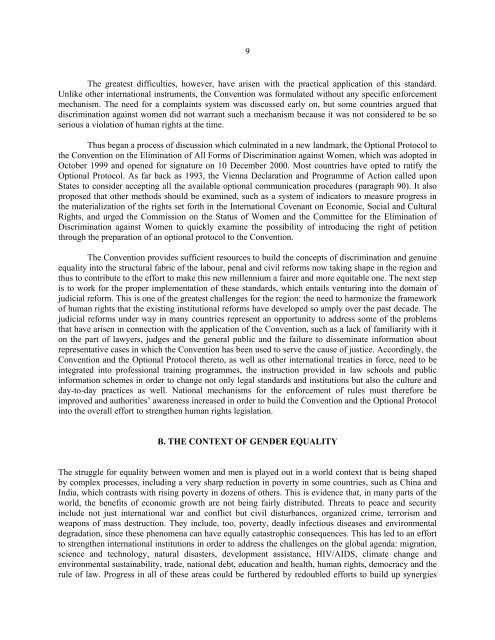Women in Latin America and the Caribbean - Cepal
Women in Latin America and the Caribbean - Cepal
Women in Latin America and the Caribbean - Cepal
You also want an ePaper? Increase the reach of your titles
YUMPU automatically turns print PDFs into web optimized ePapers that Google loves.
9<br />
The greatest difficulties, however, have arisen with <strong>the</strong> practical application of this st<strong>and</strong>ard.<br />
Unlike o<strong>the</strong>r <strong>in</strong>ternational <strong>in</strong>struments, <strong>the</strong> Convention was formulated without any specific enforcement<br />
mechanism. The need for a compla<strong>in</strong>ts system was discussed early on, but some countries argued that<br />
discrim<strong>in</strong>ation aga<strong>in</strong>st women did not warrant such a mechanism because it was not considered to be so<br />
serious a violation of human rights at <strong>the</strong> time.<br />
Thus began a process of discussion which culm<strong>in</strong>ated <strong>in</strong> a new l<strong>and</strong>mark, <strong>the</strong> Optional Protocol to<br />
<strong>the</strong> Convention on <strong>the</strong> Elim<strong>in</strong>ation of All Forms of Discrim<strong>in</strong>ation aga<strong>in</strong>st <strong>Women</strong>, which was adopted <strong>in</strong><br />
October 1999 <strong>and</strong> opened for signature on 10 December 2000. Most countries have opted to ratify <strong>the</strong><br />
Optional Protocol. As far back as 1993, <strong>the</strong> Vienna Declaration <strong>and</strong> Programme of Action called upon<br />
States to consider accept<strong>in</strong>g all <strong>the</strong> available optional communication procedures (paragraph 90). It also<br />
proposed that o<strong>the</strong>r methods should be exam<strong>in</strong>ed, such as a system of <strong>in</strong>dicators to measure progress <strong>in</strong><br />
<strong>the</strong> materialization of <strong>the</strong> rights set forth <strong>in</strong> <strong>the</strong> International Covenant on Economic, Social <strong>and</strong> Cultural<br />
Rights, <strong>and</strong> urged <strong>the</strong> Commission on <strong>the</strong> Status of <strong>Women</strong> <strong>and</strong> <strong>the</strong> Committee for <strong>the</strong> Elim<strong>in</strong>ation of<br />
Discrim<strong>in</strong>ation aga<strong>in</strong>st <strong>Women</strong> to quickly exam<strong>in</strong>e <strong>the</strong> possibility of <strong>in</strong>troduc<strong>in</strong>g <strong>the</strong> right of petition<br />
through <strong>the</strong> preparation of an optional protocol to <strong>the</strong> Convention.<br />
The Convention provides sufficient resources to build <strong>the</strong> concepts of discrim<strong>in</strong>ation <strong>and</strong> genu<strong>in</strong>e<br />
equality <strong>in</strong>to <strong>the</strong> structural fabric of <strong>the</strong> labour, penal <strong>and</strong> civil reforms now tak<strong>in</strong>g shape <strong>in</strong> <strong>the</strong> region <strong>and</strong><br />
thus to contribute to <strong>the</strong> effort to make this new millennium a fairer <strong>and</strong> more equitable one. The next step<br />
is to work for <strong>the</strong> proper implementation of <strong>the</strong>se st<strong>and</strong>ards, which entails ventur<strong>in</strong>g <strong>in</strong>to <strong>the</strong> doma<strong>in</strong> of<br />
judicial reform. This is one of <strong>the</strong> greatest challenges for <strong>the</strong> region: <strong>the</strong> need to harmonize <strong>the</strong> framework<br />
of human rights that <strong>the</strong> exist<strong>in</strong>g <strong>in</strong>stitutional reforms have developed so amply over <strong>the</strong> past decade. The<br />
judicial reforms under way <strong>in</strong> many countries represent an opportunity to address some of <strong>the</strong> problems<br />
that have arisen <strong>in</strong> connection with <strong>the</strong> application of <strong>the</strong> Convention, such as a lack of familiarity with it<br />
on <strong>the</strong> part of lawyers, judges <strong>and</strong> <strong>the</strong> general public <strong>and</strong> <strong>the</strong> failure to dissem<strong>in</strong>ate <strong>in</strong>formation about<br />
representative cases <strong>in</strong> which <strong>the</strong> Convention has been used to serve <strong>the</strong> cause of justice. Accord<strong>in</strong>gly, <strong>the</strong><br />
Convention <strong>and</strong> <strong>the</strong> Optional Protocol <strong>the</strong>reto, as well as o<strong>the</strong>r <strong>in</strong>ternational treaties <strong>in</strong> force, need to be<br />
<strong>in</strong>tegrated <strong>in</strong>to professional tra<strong>in</strong><strong>in</strong>g programmes, <strong>the</strong> <strong>in</strong>struction provided <strong>in</strong> law schools <strong>and</strong> public<br />
<strong>in</strong>formation schemes <strong>in</strong> order to change not only legal st<strong>and</strong>ards <strong>and</strong> <strong>in</strong>stitutions but also <strong>the</strong> culture <strong>and</strong><br />
day-to-day practices as well. National mechanisms for <strong>the</strong> enforcement of rules must <strong>the</strong>refore be<br />
improved <strong>and</strong> authorities’ awareness <strong>in</strong>creased <strong>in</strong> order to build <strong>the</strong> Convention <strong>and</strong> <strong>the</strong> Optional Protocol<br />
<strong>in</strong>to <strong>the</strong> overall effort to streng<strong>the</strong>n human rights legislation.<br />
B. THE CONTEXT OF GENDER EQUALITY<br />
The struggle for equality between women <strong>and</strong> men is played out <strong>in</strong> a world context that is be<strong>in</strong>g shaped<br />
by complex processes, <strong>in</strong>clud<strong>in</strong>g a very sharp reduction <strong>in</strong> poverty <strong>in</strong> some countries, such as Ch<strong>in</strong>a <strong>and</strong><br />
India, which contrasts with ris<strong>in</strong>g poverty <strong>in</strong> dozens of o<strong>the</strong>rs. This is evidence that, <strong>in</strong> many parts of <strong>the</strong><br />
world, <strong>the</strong> benefits of economic growth are not be<strong>in</strong>g fairly distributed. Threats to peace <strong>and</strong> security<br />
<strong>in</strong>clude not just <strong>in</strong>ternational war <strong>and</strong> conflict but civil disturbances, organized crime, terrorism <strong>and</strong><br />
weapons of mass destruction. They <strong>in</strong>clude, too, poverty, deadly <strong>in</strong>fectious diseases <strong>and</strong> environmental<br />
degradation, s<strong>in</strong>ce <strong>the</strong>se phenomena can have equally catastrophic consequences. This has led to an effort<br />
to streng<strong>the</strong>n <strong>in</strong>ternational <strong>in</strong>stitutions <strong>in</strong> order to address <strong>the</strong> challenges on <strong>the</strong> global agenda: migration,<br />
science <strong>and</strong> technology, natural disasters, development assistance, HIV/AIDS, climate change <strong>and</strong><br />
environmental susta<strong>in</strong>ability, trade, national debt, education <strong>and</strong> health, human rights, democracy <strong>and</strong> <strong>the</strong><br />
rule of law. Progress <strong>in</strong> all of <strong>the</strong>se areas could be fur<strong>the</strong>red by redoubled efforts to build up synergies











